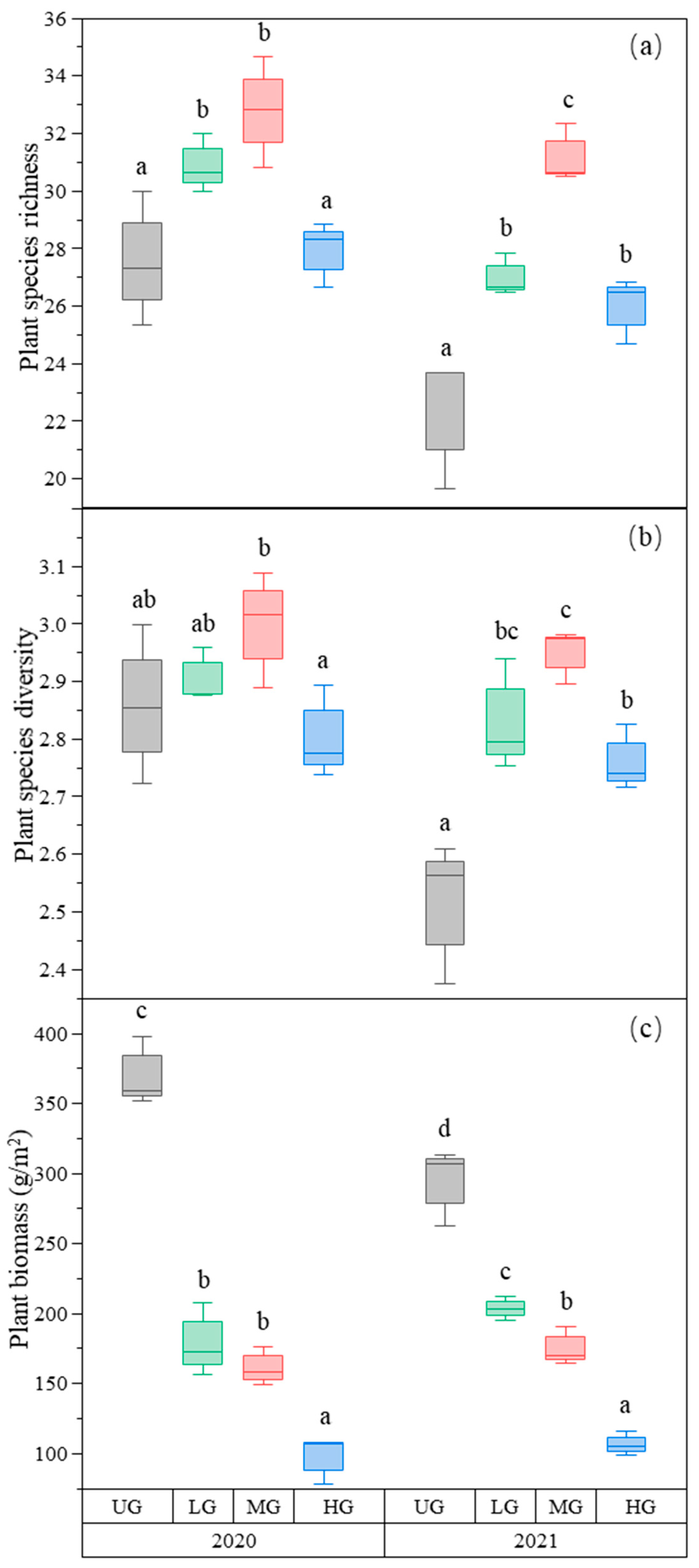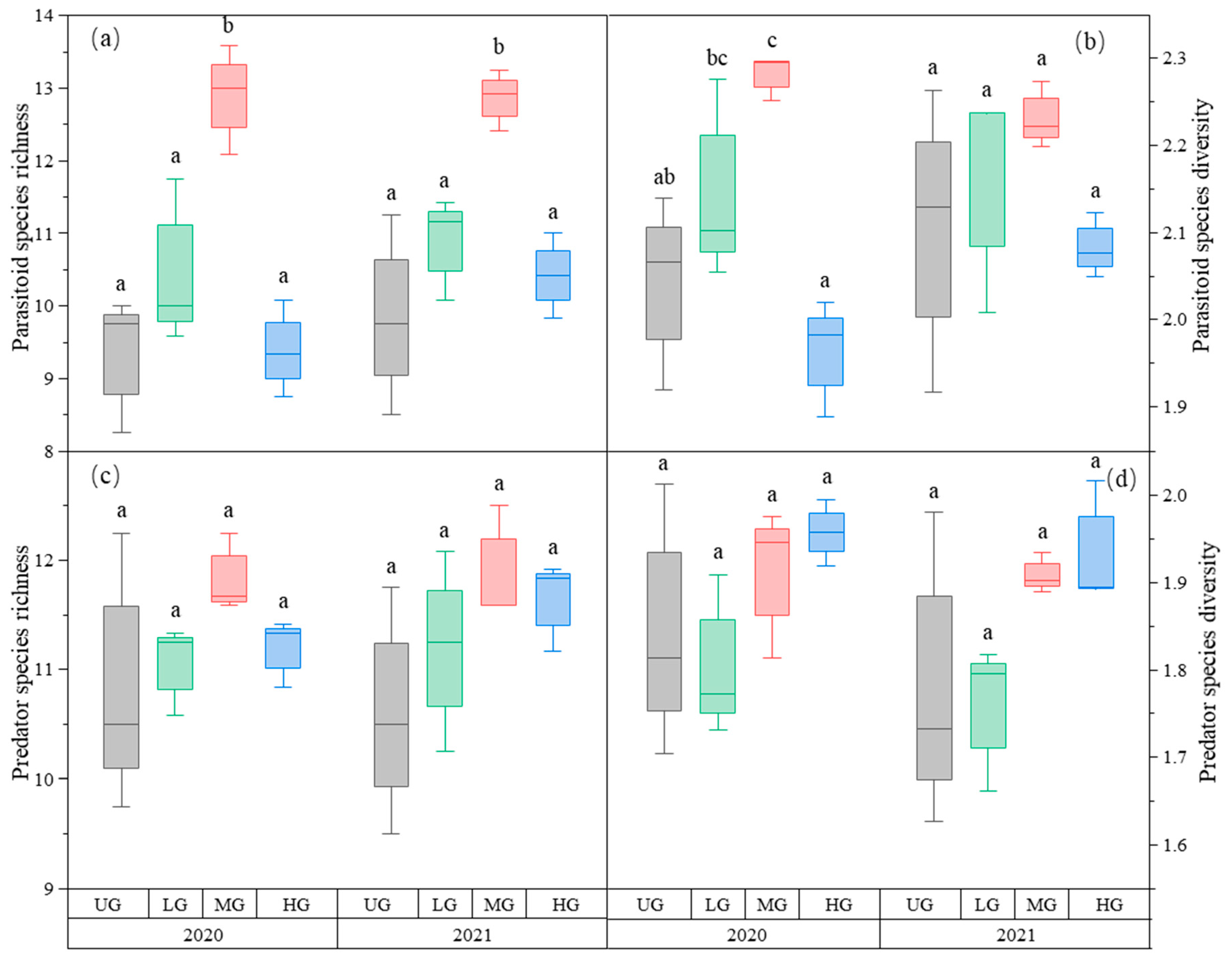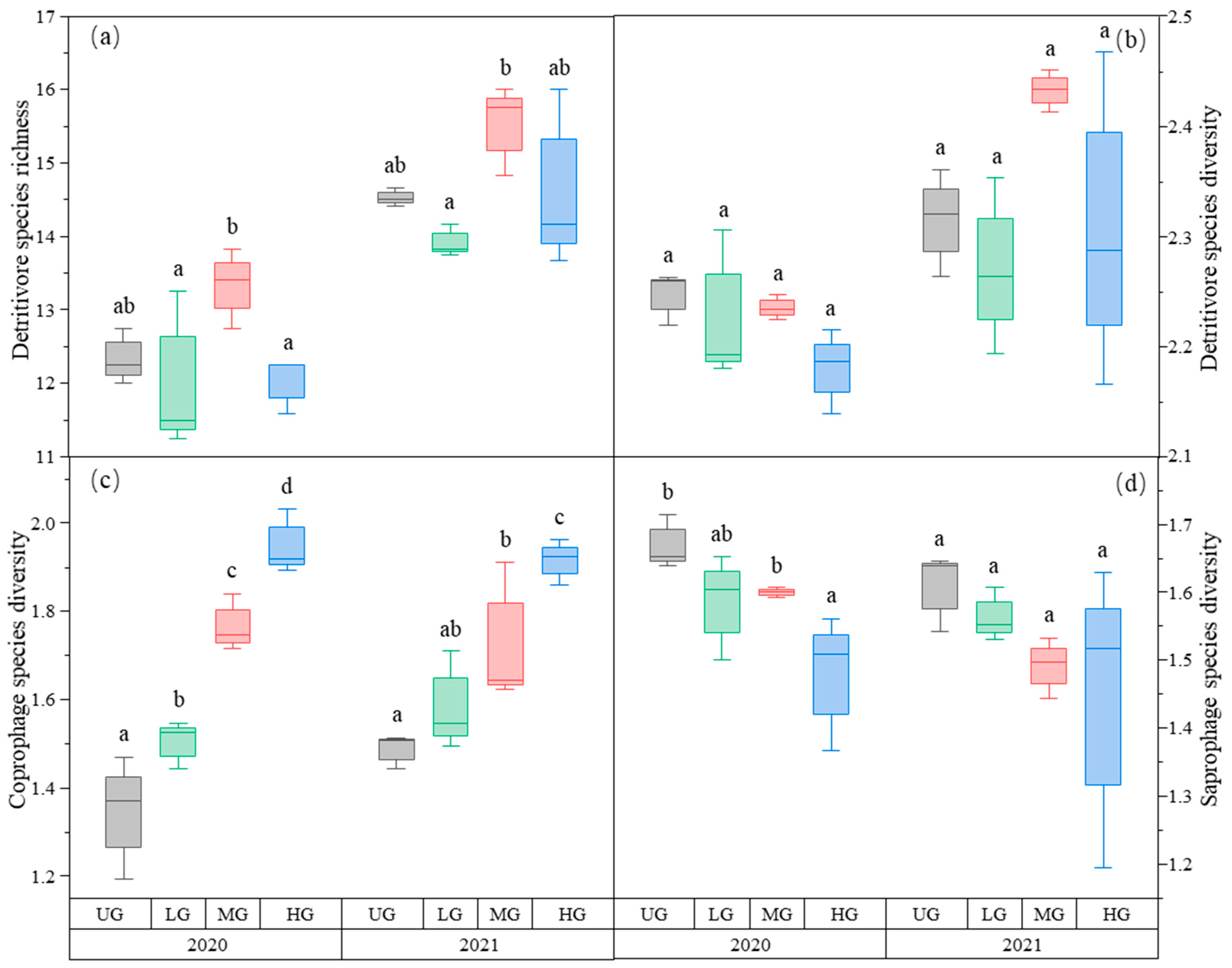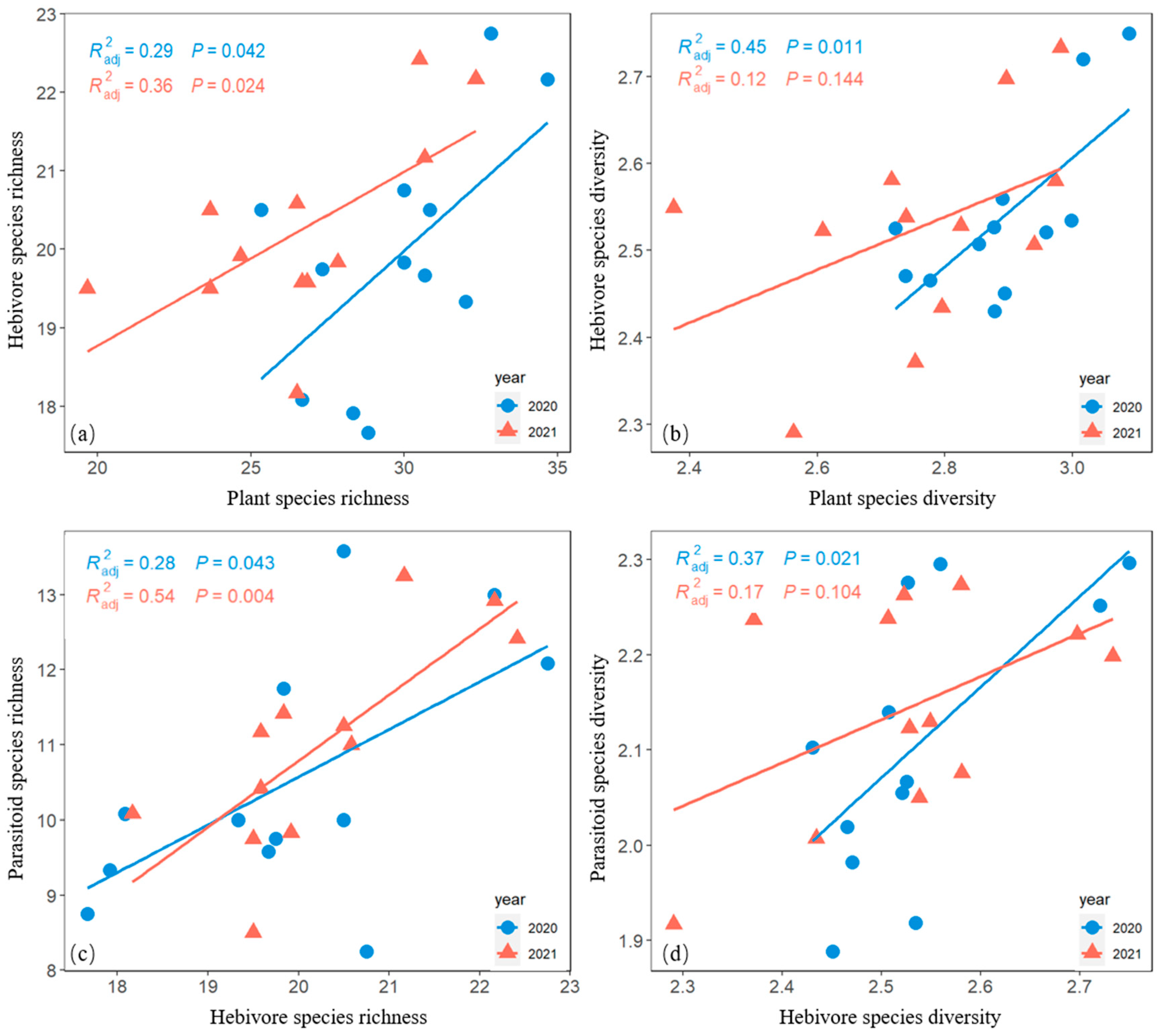Moderate Grazing Promotes Arthropod Species Diversity in an Alpine Meadow
Abstract
Simple Summary
Abstract
1. Introduction
2. Methods and Materials
2.1. Study Site
2.2. Experimental Design
2.3. Plant Sampling
2.4. Arthropod Sampling and Identification
2.5. Statistical Analysis
3. Results
3.1. Plant
3.2. Herbivores
3.3. Parasitoids and Predators
3.4. Detritivores
3.5. Overall Effects on Arthropods
3.6. Relationships among Plant, Herbivore, and Parasitoid Species Diversity
4. Discussion
5. Conclusions
Author Contributions
Funding
Institutional Review Board Statement
Informed Consent Statement
Data Availability Statement
Acknowledgments
Conflicts of Interest
References
- O’Mara, F.P. The role of grasslands in food security and climate change. Ann. Bot. 2012, 110, 1263–1270. [Google Scholar] [CrossRef]
- Bardgett, R.D.; Bullock, J.M.; Lavorel, S.; Manning, P.; Schaffner, U.; Ostle, N.; Chomel, M.; Durigan, G.; Fry, E.L.; Johnson, D.; et al. Combatting global grassland degradation. Nat. Rev. Earth Environ. 2021, 2, 720–735. [Google Scholar] [CrossRef]
- Huber, R.; Le’Clec’h, S.; Buchmann, N.; Finger, R. Economic value of three grassland ecosystem services when managed at the regional and farm scale. Sci. Rep. 2022, 12, 4194. [Google Scholar] [CrossRef] [PubMed]
- Vallentine, J.F. 5—Grazing Effects on Plants and Soil. In Grazing Management, 2nd ed.; Vallentine, J.F., Ed.; Academic Press: San Diego, CA, USA, 2001; pp. 127–165. [Google Scholar] [CrossRef]
- Krause, B.; Culmsee, H. The significance of habitat continuity and current management on the compositional and functional diversity of grasslands in the uplands of Lower Saxony, Germany. Flora 2013, 208, 299–311. [Google Scholar] [CrossRef]
- Abdalla, M.; Hastings, A.; Chadwick, D.R.; Jones, D.L.; Evans, C.D.; Jones, M.B.; Rees, R.M.; Smith, P. Critical review of the impacts of grazing intensity on soil organic carbon storage and other soil quality indicators in extensively managed grasslands. Agric. Ecosyst. Environ. 2018, 253, 62–81. [Google Scholar] [CrossRef] [PubMed]
- Liu, C.; Song, X.; Wang, L.; Wang, D.; Zhou, X.; Liu, J.; Zhao, X.; Li, J.; Lin, H.; Wan, S. Effects of grazing on soil nitrogen spatial heterogeneity depend on herbivore assemblage and pre-grazing plant diversity. J. Appl. Ecol. 2016, 53, 242–250. [Google Scholar] [CrossRef]
- Chen, W.; Wang, J.; Meng, Z.; Xu, R.; Chen, J.; Zhang, Y.; Hu, T. Fertility-related interplay between fungal guilds underlies plant richness-productivity relationships in natural grasslands. New Phytol. 2020, 226, 1129–1143. [Google Scholar] [CrossRef]
- Pulungan, M.A.; Suzuki, S.; Gavina, M.K.A.; Tubay, J.M.; Ito, H.; Nii, M.; Ichinose, G.; Okabe, T.; Ishida, A.; Shiyomi, M.; et al. Grazing enhances species diversity in grassland communities. Sci. Rep. 2019, 9, 11201. [Google Scholar] [CrossRef]
- Connell, J.H. Diversity in Tropical Rain Forests and Coral Reefs. Science 1978, 199, 1302–1310. [Google Scholar] [CrossRef]
- Sjodin, N.E.; Bengtsson, J.; Ekbom, B. The influence of grazing intensity and landscape composition on the diversity and abundance of flower-visiting insects. J. Appl. Ecol. 2008, 45, 763–772. [Google Scholar] [CrossRef]
- Scudder, G.G.E. The Importance of Insects. In Insect Biodiversity; Wiley: Hoboken, NJ, USA, 2017; pp. 9–43. [Google Scholar] [CrossRef]
- Schwarz, C.; Fartmann, T. Conservation of a strongly declining butterfly species depends on traditionally managed grasslands. J. Insect Conserv. 2021, 25, 255–271. [Google Scholar] [CrossRef]
- O’Neill, K.M.; Olson, B.E.; Wallander, R.; Rolston, M.G.; Seibert, C.E. Effects of livestock grazing on grasshopper abundance on a native rangeland in Montana. Environ. Entomol. 2010, 39, 775–786. [Google Scholar] [CrossRef] [PubMed]
- Poyry, J.; Lindgren, S.; Salminen, J.; Kuussaari, M. Restoration of butterfly and moth communities in semi-natural grasslands by cattle grazing. Ecol. Appl. 2004, 14, 1656–1670. [Google Scholar] [CrossRef]
- Vanbergen, A.J.; Hails, R.S.; Watt, A.D.; Jones, T.H. Consequences for host-parasitoid interactions of grazing-dependent habitat heterogeneity. J. Anim. Ecol. 2006, 75, 789–801. [Google Scholar] [CrossRef] [PubMed]
- Xi, X.; Eisenhauer, N.; Sun, S. Parasitoid wasps indirectly suppress seed production by stimulating consumption rates of their seed-feeding hosts. J. Anim. Ecol. 2015, 84, 1103–1111. [Google Scholar] [CrossRef]
- Iwasa, M.; Moki, Y.; Takahashi, J. Effects of the Activity of Coprophagous Insects on Greenhouse Gas Emissions from Cattle Dung Pats and Changes in Amounts of Nitrogen, Carbon, and Energy. Environ. Entomol. 2015, 44, 106–113. [Google Scholar] [CrossRef]
- Verdú, J.R.; Moreno, C.E.; Sánchez-Rojas, G.; Numa, C.; Galante, E.; Halffter, G. Grazing promotes dung beetle diversity in the xeric landscape of a Mexican Biosphere Reserve. Biol. Conserv. 2007, 140, 308–317. [Google Scholar] [CrossRef]
- Xie, M.; Wu, X.; Sun, S. Interspecific interactions between burrowing dung beetles and earthworms on yak dung removal and herbage growth in an alpine meadow. Soil Ecol. Lett. 2021, 3, 94–102. [Google Scholar] [CrossRef]
- Moran, M.D. Bison grazing increases arthropod abundance and diversity in a tallgrass prairie. Environ. Entomol. 2014, 43, 1174–1184. [Google Scholar] [CrossRef]
- Newbold, T.A.S.; Stapp, P.; Levensailor, K.E.; Derner, J.D.; Lauenroth, W.K. Community Responses of Arthropods to a Range of Traditional and Manipulated Grazing in Shortgrass Steppe. Environ. Entomol. 2014, 43, 556–568. [Google Scholar] [CrossRef]
- Simons, N.K.; Gossner, M.M.; Lewinsohn, T.M.; Lange, M.; Tuerke, M.; Weisser, W.W. Effects of land-use intensity on arthropod species abundance distributions in grasslands. J. Anim. Ecol. 2015, 84, 143–154. [Google Scholar] [CrossRef] [PubMed]
- Dennis, P.; Skartveit, J.; McCracken, D.I.; Pakeman, R.J.; Beaton, K.; Kunaver, A.; Evans, D.M. The effects of livestock grazing on foliar arthropods associated with bird diet in upland grasslands of Scotland. J. Appl. Ecol. 2008, 45, 279–287. [Google Scholar] [CrossRef]
- Moreira, X.; Abdala-Roberts, L.; Rasmann, S.; Castagneyrol, B.; Mooney, K.A. Plant diversity effects on insect herbivores and their natural enemies: Current thinking, recent findings, and future directions. Curr. Opin. Insect Sci. 2016, 14, 1–7. [Google Scholar] [CrossRef] [PubMed]
- Davis, S.C.; Burkle, L.A.; Cross, W.F.; Cutting, K.A. The Effects of Timing of Grazing on Plant and Arthropod Communities in High-Elevation Grasslands. PLoS ONE 2014, 9, e110460. [Google Scholar] [CrossRef] [PubMed]
- Torma, A.; Revesz, K.; Galle-Szpisjak, N.; Seat, J.; Szel, G.; Kutasi, C.; Malenovsky, I.; Batary, P.; Galle, R. Differences in arthropod communities between grazed areas and grazing exclosures depend on arthropod groups and vegetation types. Agric. Ecosyst. Environ. 2023, 341, 108222. [Google Scholar] [CrossRef]
- Eskelinen, A.; Harpole, W.S.; Jessen, M.T.; Virtanen, R.; Hautier, Y. Light competition drives herbivore and nutrient effects on plant diversity. Nature 2022, 611, 301–305. [Google Scholar] [CrossRef]
- Komac, B.; Pladevall, C.; Domènech, M.; Fanlo, R. Functional diversity and grazing intensity in sub-alpine and alpine grasslands in Andorra. Appl. Veg. Sci. 2015, 18, 75–85. [Google Scholar] [CrossRef]
- Halpern, B.S.; Borer, E.T.; Seabloom, E.W.; Shurin, J.B. Predator effects on herbivore and plant stability. Ecol. Lett. 2005, 8, 189–194. [Google Scholar] [CrossRef]
- Lafferty, K.D.; Dobson, A.P.; Kuris, A.M. Parasites dominate food web links. Proc. Natl. Acad. Sci. USA 2006, 103, 11211–11216. [Google Scholar] [CrossRef]
- Xi, X.; Yang, Y.; Yang, Y.; Segoli, M.; Sun, S. Plant-mediated resource partitioning by coexisting parasitoids. Ecology 2017, 98, 1660–1670. [Google Scholar] [CrossRef]
- Mittelbach, G.; Steiner, C.; Scheiner, S.; Gross, K.; Reynolds, H.; Waide, R.; Willig, M.; Dodson, S.; Gough, L. What Is the Observed Relationship between Species Richness and Productivity? Ecology 2001, 82, 2381–2396. [Google Scholar] [CrossRef]
- Barber-Cross, T.; Filazzola, A.; Brown, C.; Dettlaff, M.A.; Batbaatar, A.; Grenke, J.S.J.; Peetoom Heida, I.; Cahill, J.F., Jr. A global inventory of animal diversity measured in different grazing treatments. Sci. Data 2022, 9, 209. [Google Scholar] [CrossRef] [PubMed]
- Ortega-Martínez, I.J.; Moreno, C.E.; Rios-Díaz, C.L.; Arellano, L.; Rosas, F.; Castellanos, I. Assembly mechanisms of dung beetles in temperate forests and grazing pastures. Sci. Rep. 2020, 10, 391. [Google Scholar] [CrossRef] [PubMed]
- Garibaldi, L.A.; Semmartin, M.; Chaneton, E.J. Grazing-induced changes in plant composition affect litter quality and nutrient cycling in flooding Pampa grasslands. Oecologia 2007, 151, 650–662. [Google Scholar] [CrossRef] [PubMed]
- Negro, M.; Rolando, A.; Palestrini, C. The impact of overgrazing on dung beetle diversity in the Italian Maritime Alps. Environ. Entomol. 2011, 40, 1081–1092. [Google Scholar] [CrossRef]
- Wijas, B.J.; Cornwell, W.K.; Letnic, M. Herbivores disrupt the flow of food resources to termites in dryland ecosystems. Ecology 2023, 104, e4035. [Google Scholar] [CrossRef]
- Kruess, A.; Tscharntke, T. Grazing intensity and the diversity of grasshoppers, butterflies, and trap-nesting bees and wasps. Biol. Conserv. 2002, 16, 1570–1580. [Google Scholar] [CrossRef]
- Kruess, A.; Tscharntke, T. Contrasting responses of plant and insect diversity to variation in grazing intensity. Biol. Conserv. 2002, 106, 293–302. [Google Scholar] [CrossRef]
- da Silva Bomfim, L.; Bitencourt, J.A.G.; Rodrigues, E.N.L.; Podgaiski, L.R. The role of a rosette-shaped plant (Eryngium horridum, Apiaceae) on grassland spiders along a grazing intensity gradient. Insect Conserv. Divers. 2021, 14, 492–503. [Google Scholar] [CrossRef]
- Torma, A.; Császár, P.; Bozsó, M.; Deák, B.; Valkó, O.; Kiss, O.; Gallé, R. Species and functional diversity of arthropod assemblages (Araneae, Carabidae, Heteroptera and Orthoptera) in grazed and mown salt grasslands. Agric. Ecosyst. Environ. 2019, 273, 70–79. [Google Scholar] [CrossRef]
- Hu, X.; Zhou, W.; Li, X.; Niklas, K.J.; Sun, S. Changes in Community Composition Induced by Experimental Warming in an Alpine Meadow: Beyond Plant Functional Type. Front. Ecol. Evol. 2021, 9, 569422. [Google Scholar] [CrossRef]
- Mipam, T.D.; Zhong, L.L.; Liu, J.Q.; Miehe, G.; Tian, L.M. Productive Overcompensation of Alpine Meadows in Response to Yak Grazing in the Eastern Qinghai-Tibet Plateau. Front. Plant Sci. 2019, 10, 925. [Google Scholar] [CrossRef]
- Mipam, T.D.; Chen, S.; Liu, J.; Miehe, G.; Tian, L. Short-term yak-grazing alters plant-soil stoichiometric relations in an alpine meadow on the eastern Tibetan Plateau. Plant Soil 2019, 458, 125–137. [Google Scholar] [CrossRef]
- Whitman, J.D.; Yanega, D.; Watson, C.B.G.; Strode, V.W. Collection and Preservation of Terrestrial Arthropods. In Biobanking: Methods and Protocols; Yong, W.H., Ed.; Springer: New York, NY, USA, 2019; pp. 163–189. [Google Scholar] [CrossRef]
- Ikemoto, M.; Kuramitsu, K.; Sueyoshi, M.; Seguchi, S.; Yokoi, T. Relative trapping efficiencies of different types of attraction traps for three insect orders in an agricultural field. Appl. Entomol. Zool. 2021, 56, 393–405. [Google Scholar] [CrossRef]
- Brown, G.R.; Matthews, I.M. A review of extensive variation in the design of pitfall traps and a proposal for a standard pitfall trap design for monitoring ground-active arthropod biodiversity. Ecol. Evol. 2016, 6, 3953–3964. [Google Scholar] [CrossRef]
- Perner, J.; Voigt, W.; Bährmann, R.; Heinrich, W.; Marstaller, R.; Fabian, B.; Gregor, K.; Lichter, D.; Sander, F.W.; Jones, T.H. Responses of arthropods to plant diversity: Changes after pollution cessation. Ecography 2003, 26, 788–800. [Google Scholar] [CrossRef]
- Watts, J.G.; Huddleston, E.W.; Owens, J.C. Rangeland entomology. Annu. Rev. Entomol. 1982, 27, 283–311. [Google Scholar] [CrossRef]
- Braaker, S.; Obrist, M.K.; Ghazoul, J.; Moretti, M. Habitat connectivity and local conditions shape taxonomic and functional diversity of arthropods on green roofs. J. Anim. Ecol. 2017, 86, 521–531. [Google Scholar] [CrossRef]
- Koricheva, J.; Mulder, C.P.; Schmid, B.; Joshi, J.; Huss-Danell, K. Numerical responses of different trophic groups of invertebrates to manipulations of plant diversity in grasslands. Oecologia 2000, 125, 271–282. [Google Scholar] [CrossRef]
- Ganjurjav, H.; Duan, M.-J.; Wan, Y.-F.; Zhang, W.-N.; Gao, Q.-Z.; Li, Y.; Jiangcun, W.-Z.; Danjiu, L.-B.; Guo, H.-B. Effects of grazing by large herbivores on plant diversity and productivity of semi-arid alpine steppe on the Qinghai-Tibetan Plateau. Rangel. J. 2015, 37, 389. [Google Scholar] [CrossRef]
- Joubert, L.; Pryke, J.S.; Samways, M.J. Moderate grazing sustains plant diversity in Afromontane grassland. Appl. Veg. Sci. 2017, 20, 340–351. [Google Scholar] [CrossRef]
- Borer, E.T.; Seabloom, E.W.; Gruner, D.S.; Harpole, W.S.; Hillebrand, H.; Lind, E.M.; Adler, P.B.; Alberti, J.; Anderson, T.M.; Bakker, J.D.; et al. Herbivores and nutrients control grassland plant diversity via light limitation. Nature 2014, 508, 517–520. [Google Scholar] [CrossRef]
- Herrero-Jáuregui, C.; Oesterheld, M. Effects of grazing intensity on plant richness and diversity: A meta-analysis. Oikos 2018, 127, 757–766. [Google Scholar] [CrossRef]
- Zhang, Z.; Zhao, Y.; Lin, H.; Li, Y.; Fu, J.; Wang, Y.; Sun, J.; Zhao, Y. Comprehensive analysis of grazing intensity impacts alpine grasslands across the Qinghai-Tibetan Plateau: A meta-analysis. Front. Plant Sci. 2022, 13, 1083709. [Google Scholar] [CrossRef]
- Cui, G.X.; Degen, A.A.; Wei, X.X.; Zhou, J.W.; Ding, L.M.; Shang, Z.H.; Wei, X.H.; Long, R.J. Trolox equivalent antioxidant capacities and fatty acids profile of 18 alpine plants available as forage for yaks on the Qinghai-Tibetan Plateau. Rangel. J. 2016, 38, 373–380. [Google Scholar] [CrossRef]
- Nalam, V.; Louis, J.; Shah, J. Plant defense against aphids, the pest extraordinaire. Plant Sci. 2019, 279, 96–107. [Google Scholar] [CrossRef]
- Bai, Y.; Yang, C.; Halitschke, R.; Paetz, C.; Kessler, D.; Burkard, K.; Gaquerel, E.; Baldwin, I.T.; Li, D. Natural history—Guided omics reveals plant defensive chemistry against leafhopper pests. Science 2022, 375, eabm2948. [Google Scholar] [CrossRef]
- Mound, L.A.; Wang, Z.; Lima, É.F.B.; Marullo, R. Problems with the Concept of “Pest” among the Diversity of Pestiferous Thrips. Insects 2022, 13, 61. [Google Scholar] [CrossRef]
- Yamamoto, S.; Uchida, K. A generalist herbivore requires a wide array of plant species to maintain its populations. Biol. Conserv. 2018, 228, 167–174. [Google Scholar] [CrossRef]
- Lan, B.; Dong, Y.; Niklas, K.J.; Sun, S. Dietary differences between grasshoppers are associated with life history tradeoffs in an alpine meadow. Ecol. Res. 2021, 36, 842–853. [Google Scholar] [CrossRef]
- Zhu, H.; Nkurunziza, V.; Wang, J.; Guo, Q.; Ruan, H.; Wang, D. Effects of large herbivore grazing on grasshopper behaviour and abundance in a meadow steppe. Ecol. Entomol. 2020, 45, 1357–1366. [Google Scholar] [CrossRef]
- Xi, X.; Wu, X.; Nylin, S.; Sun, S. Body size response to warming: Time of the season matters in a tephritid fly. Oikos 2016, 125, 386–394. [Google Scholar] [CrossRef]
- Richter, V.; Kasparyan, D. Tachinid (Diptera, Tachinidae) parasitoids of sawflies (Hymenoptera, Symphyta). Entomol. Rev. 2013, 93, 630–633. [Google Scholar] [CrossRef]
- Miura, K. Parasitism of Parapodisma grasshopper species by the flesh fly, Blaesoxipha japonensis (Hori) (Diptera: Sarcophagidae). Appl. Entomol. Zool. 2003, 38, 537–542. [Google Scholar] [CrossRef]
- Laws, A.N.; Joern, A. Variable effects of dipteran parasitoids and management treatment on grasshopper fecundity in a tallgrass prairie. Bull. Entomol. Res. 2012, 102, 123–130. [Google Scholar] [CrossRef] [PubMed]
- Turlings, T.C.; Loughrin, J.H.; McCall, P.J.; Röse, U.S.; Lewis, W.J.; Tumlinson, J.H. How caterpillar-damaged plants protect themselves by attracting parasitic wasps. Proc. Natl. Acad. Sci. USA 1995, 92, 4169–4174. [Google Scholar] [CrossRef] [PubMed]
- Gibson, C.W.D.; Hambler, C.; Brown, V.K. Changes in Spider (Araneae) Assemblages in Relation to Succession and Grazing Management. J. Appl. Ecol. 1992, 29, 132–142. [Google Scholar] [CrossRef]
- Michalko, R.; Pekár, S.; Entling, M.H. An updated perspective on spiders as generalist predators in biological control. Oecologia 2019, 189, 21–36. [Google Scholar] [CrossRef]
- McCravy, K.W.; Lundgren, J.G. Carabid beetles (Coleoptera: Carabidae) of the Midwestern United States: A review and synthesis of recent research. Terr. Arthropod Rev. 2011, 4, 63–94. [Google Scholar] [CrossRef]
- Rohlfs, M.; Kürschner, L. Saprophagous insect larvae, Drosophila melanogaster, profit from increased species richness in beneficial microbes. J. Appl. Entomol. 2010, 134, 667–671. [Google Scholar] [CrossRef]
- Ponge, J.-F. Plant–soil feedbacks mediated by humus forms: A review. Soil Biol. Biochem. 2013, 57, 1048–1060. [Google Scholar] [CrossRef]
- Wu, X.-W.; Sun, S.-C. Artificial Warming Advances Egg-Laying and Decreases Larval Size in the Dung BeetleAphodius erraticus (Coleoptera: Scarabaeidae) in a Tibetan Alpine Meadow. Ann. Zool. Fenn. 2012, 49, 174–180. [Google Scholar] [CrossRef]






| 2020 | 2021 | |||
|---|---|---|---|---|
| F | p | F | p | |
| Plant species richness | 6.225 | 0.017 | 15.222 | 0.001 |
| Plant species diversity | 2.168 | 0.170 | 13.257 | 0.002 |
| Plant biomass (g/m2) | 93.480 | <0.001 | 65.589 | <0.001 |
| Herbivore species richness | 20.547 | <0.001 | 8.379 | 0.008 |
| Herbivore species diversity | 7.921 | 0.009 | 4.287 | 0.044 |
| Parasitoid species richness | 9.003 | 0.006 | 5.959 | 0.019 |
| Parasitoid species diversity | 7.222 | 0.012 | 1.048 | 0.423 |
| Predator species richness | 1.101 | 0.404 | 1.555 | 0.274 |
| Predator species diversity | 1.338 | 0.329 | 2.094 | 0.179 |
| Detritivore species richness | 2.570 | 0.127 | 2.765 | 0.111 |
| Detritivore species diversity | 1.495 | 0.288 | 1.846 | 0.217 |
| Coprophage species diversity | 27.029 | <0.001 | 9.666 | 0.005 |
| Saprophage species diversity | 4.121 | 0.049 | 1.095 | 0.405 |
| Arthropod species richness | 20.812 | <0.001 | 18.825 | 0.001 |
| Arthropod species diversity | 11.168 | 0.003 | 4.797 | 0.034 |
| Year | Plant Functional Group | Grazing Intensity | F | p | |||
|---|---|---|---|---|---|---|---|
| UG | LG | MG | HG | ||||
| 2020 | Grass | 0.51 ± 0.09 b | 0.17 ± 0.04 a | 0.19 ± 0.05 a | 0.1 ± 0.01 a | 10.948 | 0.003 |
| Sedge | 0.11 ± 0.04 a | 0.24 ± 0.03 b | 0.18 ± 0.05 ab | 0.18 ± 0.03 ab | 2.085 | 0.181 | |
| Legume | 0.01 ± 0.002 a | 0.03 ± 0.003 b | 0.03 ± 0.006 b | 0.04 ± 0.008 b | 6.503 | 0.015 | |
| Forb | 0.38 ± 0.06 a | 0.56 ± 0.07 b | 0.6 ± 0.07 b | 0.68 ± 0.04 b | 4.682 | 0.036 | |
| 2021 | Grass | 0.4 ± 0.07 b | 0.25 ± 0.03 a | 0.25 ± 0.05 a | 0.14 ± 0.03 a | 5.123 | 0.029 |
| Sedge | 0.3 ± 0.07 a | 0.24 ± 0.02 a | 0.21 ± 0.04 a | 0.23 ± 0.01 a | 0.974 | 0.451 | |
| Legume | 0.01 ± 0.004 a | 0.03 ± 0.002 b | 0.03 ± 0.007 b | 0.02 ± 0.005 ab | 2.438 | 0.139 | |
| Forb | 0.29 ± 0.07 a | 0.48 ± 0.04 b | 0.51 ± 0.09 b | 0.62 ± 0.03 b | 4.545 | 0.039 | |
Disclaimer/Publisher’s Note: The statements, opinions and data contained in all publications are solely those of the individual author(s) and contributor(s) and not of MDPI and/or the editor(s). MDPI and/or the editor(s) disclaim responsibility for any injury to people or property resulting from any ideas, methods, instructions or products referred to in the content. |
© 2023 by the authors. Licensee MDPI, Basel, Switzerland. This article is an open access article distributed under the terms and conditions of the Creative Commons Attribution (CC BY) license (https://creativecommons.org/licenses/by/4.0/).
Share and Cite
Guan, H.; Zhang, S.; Huangpu, Y.; Yan, H.; Niklas, K.J.; Mipam, T.D.; Sun, S. Moderate Grazing Promotes Arthropod Species Diversity in an Alpine Meadow. Biology 2023, 12, 778. https://doi.org/10.3390/biology12060778
Guan H, Zhang S, Huangpu Y, Yan H, Niklas KJ, Mipam TD, Sun S. Moderate Grazing Promotes Arthropod Species Diversity in an Alpine Meadow. Biology. 2023; 12(6):778. https://doi.org/10.3390/biology12060778
Chicago/Turabian StyleGuan, Huanhuan, Shangyun Zhang, Yifei Huangpu, Han Yan, Karl J. Niklas, Tserang Donko Mipam, and Shucun Sun. 2023. "Moderate Grazing Promotes Arthropod Species Diversity in an Alpine Meadow" Biology 12, no. 6: 778. https://doi.org/10.3390/biology12060778
APA StyleGuan, H., Zhang, S., Huangpu, Y., Yan, H., Niklas, K. J., Mipam, T. D., & Sun, S. (2023). Moderate Grazing Promotes Arthropod Species Diversity in an Alpine Meadow. Biology, 12(6), 778. https://doi.org/10.3390/biology12060778







